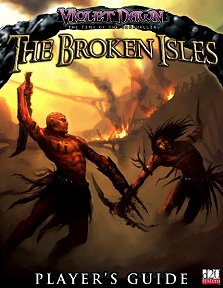
At last, after some tantalising hints and a series of fascinating creatures, material designed to empower play in the Avadnu setting arrives! An interesting approach here, rather than the usual big world book, we have here a detailed discussion of a small and isolated area, the Broken Isles where, even to the natives, the rest of the world is unexplored and unknown territory. This means that players only need to understand and know about a small area with a limited history and background, and will have a genuine feeling of exploration as their characters venture further afield.
The first chapter deals with the races available. As well as humans (of which there are four distinct groups) there are ngakoi, skarren and zeidians living there, all of which are suitable to be PCs. The other character races of the Player's Handbook are not to be found here. The human tribes would have you believe that they are all different, but they have more in common with each other than they'd care to admit. Ngakoi use magic almost instinctively and blend in with their surroundings... and have 3 eyes. Skarren, the first race to colonise the Isles, are very warlike; and zeidians are a secretive bunch, concerned with deep mysteries. The usual details of background, general lifestyle and upbringing, rules bits, languages, etc., are provided for each race. All races here are fairly basic and barbaric, living close to and off the land - if you prefer to play a cultured and elegant individual, this may not be the best place for you!
The next chapter looks in more detail at the human tribes... probably a wise move as the other races are quite strange, and could prove difficult to play in the classic 'adventuring party' mode as the interplay between them could prove quite a challenge. Each tribe has its own history and customs, and indeed even they do not mix well; rarely having contact with each other except for occasional trade and skirmishes - all-out war is rare as that will usually bring the Skarren around, joining first with whoever they deem to be the weaker to defeat their opponents then turning on their former allies and attempting to wipe them out as well. However, all four tribes are very primitive, rarely using metal and living closely in harmony with their chosen lands. Religion is generally animistic or designed to appease whatever powers they believe are around.
Next comes a chapter on classes. While all classes from the Player's Handbook except that of the cleric are available, anyone who is a druid, sorcerer or wizard will be regarded as a shaman irrespective of the true nature of his powers. Barbarians and fighters are understandably common, while bards serve as keepers of oral tradition - few save the Inul tribe of humans and the zeidians are literate. Rogues and rangers also flourish while paladins and monks are more rare, but can exist. Due to a distrust of magic, particularly that acquired by means other than studying with an established shaman, those classes which gain mystical abilities at higher levels have the option of taking other benefits instead.
A collection of feats follows: some available to all and some which can only be acquired by members of specific races or tribes (or those whom they favour with instruction).
The final chapter examines typical equipment of the Broken Isles, which - given the area's primitive nature - is somewhat different from more conventional equipment lists. Most trade is by barter, so new characters receive their starting wealth in appropriate 'trade goods' rather than cash. Metal is quite rare, and a lot of bone, flint, obsidian and wood is used instead. Both weapons and armour take on a wholly-new style.
This is a very different game setting from many, with primitive tribes roaming an uncivilised land - a fascinating challenge for anyone looking for something different. Indications are that the mainland is somewhat more developed which should prove interesting for those characters who explore that far. The concept of starting off in a remote area is a good one, it means that the players are not overwhelmed with a lot of information but can assimilate what's provided about the area they begin in, and have the fun of exploring the rest as their characters venture forth. For those less happy about being noble savages, it could be used as a resource for a primitive land that more cultured sould might visit, of course. Overall, it is well put together and provides scope for a truly original campaign.
Return to Player's Guide to the Broken Isles page.
Reviewed: 14 May 2006

